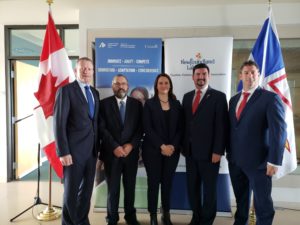24/07/2019 | Return to Latest News
The growing global demand for remote sensing information to inform priorities such as business intelligence, environmental stewardship, and safety and security is being addressed by an emerging generation of milk-carton to microwave sized satellites (smallsats). These smallsats are not only smaller, but more agile, more cost-effective and have shorter timelines to launch than traditional satellites.
The result is an increasing number of satellites imaging the Earth more often, capturing vastly increased levels of detail much more frequently. This yields unprecedented quantities of image data that must be downlinked in order to be useful. C-CORE is meeting this demand with innovative, agile and cost-effective ground stations in strategic locations that enable maximum access to satellites (and the data they capture) at very cost-effective price points.
The first ground station was developed as part of a strategic partnership with Boeing Phantom Works and deployed in Inuvik, NWT at Natural Resources Canada’s Inuvik Satellite Station Facility. Inuvik is an ideal location to access the maximum number of satellite orbits, supporting the satellite company’s needs and getting valuable data into the hands of decision-makers as quickly as possible. The ground station’s innovative self-leveling platform to compensate for the seasonal frost and thaw cycles avoids more capital intensive solutions. More detailed information on C-CORE’s Arctic ground station is available here.
This Arctic ground station has been downlinking data from GHGSat’s Claire satellite since late 2017, providing GHGSat’s clients with greenhouse gas emission measurements for a wide variety of uses.

C-CORE CEO Paul Griffin and C-CORE Board Chair David Oake celebrate project funding with Newfoundland & Labrador MHA Sarah Stoodly; Provincial Innovation Minister, Hon. Christopher Mitchelmore; and Nick Whelan, Member of Parliament for St. John’s East, representing Hon. Navdeep Bains, Minister of Innovation, Science and Economic Development and Minister responsible for ACOA
With support from the Atlantic Canada Opportunities Agency (ACOA) and Newfoundland and Labrador’s Department of Tourism, Culture, Industry and Innovation (see the funding press release here), C-CORE will expand its network with a second station in Happy Valley – Goose Bay at the College of the North Atlantic site, late in 2019. It will have additional capabilities: the ability to transmit as well as receive data and Ultra High Frequency (UHF) capability for lower-orbit or on-Earth downlink or uplink. Once our Happy Valley – Goose Bay station is operational, we will upgrade the Inuvik station with these enhanced capabilities.
The coverage provided by both ground stations spans Canada’s Arctic and addresses Eastern Arctic gaps in existing ground station coverages.
C-CORE’s novel groundstations are an essential component of the 21st century satellite system – the component that draws down the masses of data that’s being collected by an ever-increasing fleet of satellites. They start the processing chain that turns radio signals into usable information, and gets it into the hands of the data analysts who can turn it into meaningful, actionable insights for everything from business intelligence to safety, security and environmental stewardship.
